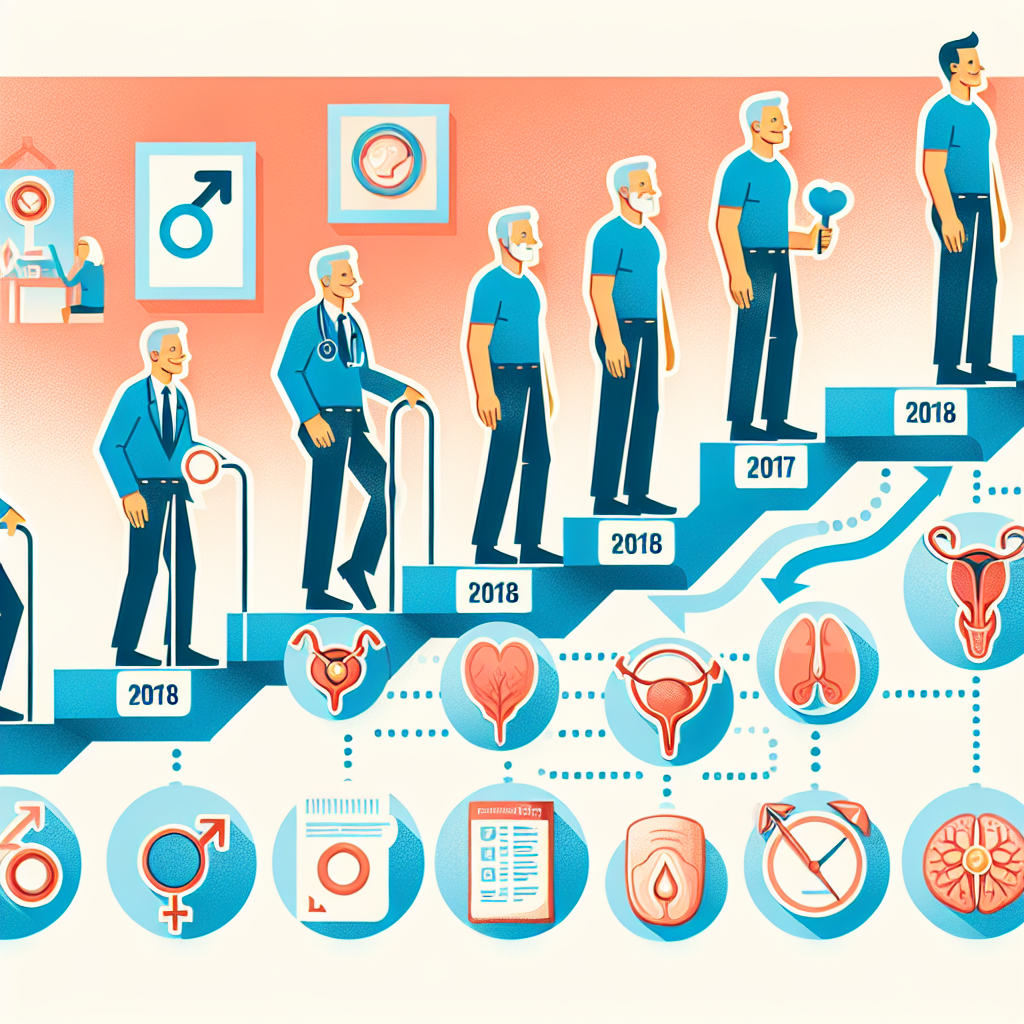Prostate Health Timeline: Key Screenings & Proactive Tips by Age
Why Prostate Health Matters More Than You Think
Prostate health is an essential part of a man’s overall wellness, yet it is often overlooked until symptoms become noticeable. The prostate gland—about the size of a walnut and located just below the bladder—plays a vital role in urinary and reproductive function. As men age, the chances of developing prostate conditions such as benign prostatic hyperplasia (BPH), prostatitis, or prostate cancer significantly increase. According to the American Cancer Society, approximately 1 in 8 men will be diagnosed with prostate cancer in their lifetime (American Cancer Society, 2023). Taking a proactive, decade-by-decade approach to screenings and lifestyle habits can dramatically improve long-term health outcomes.
Let’s explore what to expect in each stage of life and how to take control of your prostate health.
In Your 20s: Lay the Groundwork for Lifelong Prostate Health
In your 20s, the prostate generally functions optimally, and issues are rare. However, this is the ideal decade to establish healthy habits that can reduce your risk of prostate problems down the line.
Key Focus Areas:
– Live an active lifestyle: Aim for regular exercise and adopt a balanced diet with plenty of leafy greens, tomatoes rich in lycopene, and whole grains. These habits support overall prostate health.
– Minimize known risks: Limit your intake of red and processed meats, saturated fats, and alcohol. Avoid smoking. Research shows that a diet rich in fruits and vegetables correlates with a lower risk of prostate cancer (Harvard Health, 2021).
– Know your family history: If your father, grandfather, or brother had prostate cancer, share this with your healthcare provider at an early age. Genetic history may necessitate earlier screenings.
Quick Insight: Think of your prostate care like retirement planning—it may not feel critical now, but early investment pays off in the future.
In Your 30s: Increase Awareness and Stay Ahead
Although prostate problems remain uncommon during your 30s, staying vigilant and recognizing early symptoms is smart.
Key Actions:
– Watch for warning signs: Issues such as pelvic pain, discomfort during urination, or increased urinary frequency could indicate prostatitis, even in younger men.
– Maintain healthy routines: Continue consuming foods rich in antioxidants and staying physically active to minimize inflammation and preserve prostate function.
– Discuss risks with your doctor: If you haven’t yet reviewed your family history or other risk factors with your physician, now is the time.
Expert Insight: “Men often ignore urinary symptoms until they become disruptive,” says Dr. James Holden, a board-certified urologist. “Even in your 30s, flagging new symptoms can lead to better outcomes through early diagnosis.”
In Your 40s: Begin Proactive Prostate Planning
Your 40s are a pivotal time to start taking more control over your prostate health, particularly if you have elevated risk factors like a family history or are African American.
Key Focus Areas:
– Establish a baseline: A prostate-specific antigen (PSA) blood test may be recommended, especially if you’re at higher risk. African American men, for example, are 76% more likely to be diagnosed with prostate cancer (CDC, 2023).
– Consider a Digital Rectal Exam (DRE): This simple physical exam helps detect changes in size or shape of the prostate that may not show up in lab results.
– Recognize early signs of BPH: Nighttime urination, weak urine stream, or trouble starting urination could be early indicators of benign prostate enlargement.
Helpful Resource: Need to learn more about common symptoms or treatments for BPH? Visit https://www.edrugstore.com/ for medically-reviewed guidance.
In Your 50s: Make Prostate Screening a Priority
At age 50 and beyond, prostate screenings become a regular and essential part of maintaining your health—even if you’ve had no prior symptoms.
Screenings You’ll Likely Undergo:
– PSA Testing: Annual or biannual PSA tests are typically recommended starting at age 50. Elevated PSA levels may indicate prostate cancer or other conditions.
– Digital Rectal Exam (DRE): Often performed alongside PSA testing to identify changes not visible through bloodwork.
– Follow-up procedures: If PSA levels are high, your doctor may suggest further testing such as an MRI or prostate biopsy.
Lifestyle Tips:
– Manage BPH symptoms: Nearly half of men in their 50s are affected by BPH (Mayo Clinic, 2023). Treatment options include medications and minimally invasive procedures.
– Stay physically active: Cardiovascular workouts and strength training promote both prostate and overall health while managing inflammation and weight.
Clarifying Example: Think of PSA and DRE results like your health’s credit report—worth checking annually to catch any issues early.
In Your 60s: Monitor Symptoms and Weigh Treatment Options
Prostate health challenges become more prevalent in your 60s. The risk of prostate cancer peaks between ages 65 and 74 (National Cancer Institute, 2023).
Suggested Healthcare Strategies:
– Continue routine monitoring: Yearly PSA tests and DREs remain important for tracking changes in your prostate.
– Understand your treatment options: If diagnosed with prostate cancer, your doctor will help you choose between active surveillance, radiation therapy, surgery, or hormone therapy based on your health status and cancer stage.
– Manage symptoms and medication side effects: Talk with your doctor about managing potential effects like fatigue, libido changes, or bladder control issues. Medications such as alpha-blockers or 5-alpha-reductase inhibitors can help with BPH symptoms.
Specialist Insight: “In their 60s, men often balance treatment strategies with lifestyle priorities,” explains oncology specialist Dr. Andrea Lin. “It’s important to choose care options aligned with personal values and medical needs.”
In Your 70s and Beyond: Personalize Your Prostate Care
As you reach your 70s, prostate care strategies often shift toward preserving comfort and quality of life.
Caring Guidelines:
– Evaluate PSA testing needs: For men over 70 without prior prostate issues, routine PSA screening may no longer be necessary. Discuss the pros and cons with your physician.
– Consider active surveillance: Many prostate cancers in older men grow slowly. In cases where the cancer is not aggressive, active monitoring might be better than surgery or chemotherapy.
– Emphasize daily comfort: Treatment choices should focus on minimizing side effects, preserving independence, and maintaining overall well-being.
Helpful Resource: Curious about medication options for managing late-life prostate symptoms? Visit https://www.edrugstore.com/ for professional advice.
Final Thoughts: Take Control of Your Prostate Health Journey
Prostate health evolves over time, and the earlier you begin caring for it, the better. Just as you’d create a financial retirement plan, working with your doctor to build a personalized prostate care strategy can yield lifelong benefits.
Remember: Most prostate conditions are highly treatable when caught early. Don’t wait for symptoms to affect your life. Stay informed, book your screenings, and take proactive steps to maintain your health.
Are You Due for a Screening?
Be proactive about your health. Save this comprehensive guide and use it to discuss screening and lifestyle strategies with your healthcare provider.
Sources:
– American Cancer Society. (2023). Prostate Cancer Facts & Figures. https://www.cancer.org
– Centers for Disease Control and Prevention (CDC). (2023). Prostate Cancer Statistics. https://www.cdc.gov
– Harvard Health Publishing. (2021). Diet and Prostate Health. https://www.health.harvard.edu
– Mayo Clinic. (2023). Benign Prostatic Hyperplasia (BPH). https://www.mayoclinic.org
– National Cancer Institute. (2023). Age and Prostate Cancer Risk. https://www.cancer.gov
This article is for informational purposes only and does not substitute professional medical advice. Always consult your healthcare provider regarding your specific situation.



